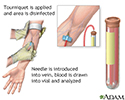Campylobacter serology test
Campylobacter serology test is a blood test to look for antibodies to bacteria called campylobacter.
A blood sample is needed.
The sample is sent to a lab. There, tests are done to look for antibodies to campylobacter bacteria. Antibody production increases during the infection. When the illness first starts, few antibodies are detected. For this reason, blood tests may need to be repeated 10 days to 2 weeks later to increase sensitivity.
How to Prepare for the Test
There is no special preparation.
How the Test will Feel
When the needle is inserted to draw blood, some people feel moderate pain. Others feel only a prick or stinging. Afterward, there may be some throbbing or a slight bruise. This soon goes away.
Why the Test is Performed
This test detects the presence of antibodies to campylobacter in the blood. Campylobacter infection can cause diarrheal illness. A blood test is rarely done to diagnose campylobacter diarrheal illness. It is used if your health care provider thinks you are having complications from this infection, such as reactive arthritis or Guillain-Barré syndrome.
Normal Results
A normal test result means no antibodies to campylobacter are present. This is called a negative result.
Normal value ranges may vary slightly among different laboratories. Talk to your provider about the meaning of your specific test results.
What Abnormal Results Mean
An abnormal (positive) result means that antibodies against campylobacter have been detected. This means you have come in contact with the bacteria.
Tests are often repeated during the course of an illness to detect a rise in antibody levels. This rise helps to confirm an active infection. A low level may be a sign of a previous infection rather than current disease.
Risks
Veins and arteries vary in size from one person to another and from one side of the body to the other. Obtaining a blood sample from some people may be more difficult than from others.
Other risks associated with having blood drawn are slight, but may include:
- Excessive bleeding
- Fainting or feeling lightheaded
- Hematoma (blood buildup under the skin)
- Infection (a slight risk any time the skin is broken)
References
Allos BM. Campylobacter infections. In: Goldman L, Cooney KA, eds. Goldman-Cecil Medicine. 27th ed. Philadelphia, PA: Elsevier; 2024:chap 279.
Allos BM, Blaser MJ, Iovine NM, Kirkpatrick BD. Campylobacter jejuni and related species. In: Bennett JE, Dolin R, Blaser MJ, eds. Mandell, Douglas, and Bennett's Principles and Practice of Infectious Diseases. 9th ed. Philadelphia, PA: Elsevier; 2020:chap 216.
Melia JMP, Sears CL. Infectious enteritis and proctocolitis. In: Feldman M, Friedman LS, Brandt LJ, eds. Sleisenger and Fordtran's Gastrointestinal and Liver Disease. 11th ed. Philadelphia, PA: Elsevier; 2021:chap 110.
Review Date: 3/16/2024









